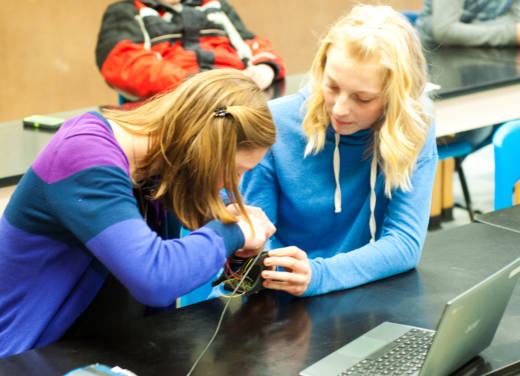First, Hammill created step-by-step instructions on his website to provide students some structure for such a new project. He then used a $500 grant from Montana State University to purchase enough equipment to make seven air sensors. All of his students were able to build those sensors in class, a project that included putting together hardware and software that could transmit data to the internet.
Then students had the opportunity to make modifications to the air sensors, such as having the light color change to represent different air quality measures. Students -- who had unfettered access to their sensors -- also worked on making them more adaptable to different environments.
“They were working on wearable models you could just use a battery with and put in your pocket,” said Hammill. This would let students publish their real-time exposure to air pollutants at their exact location. Students also had the challenge of making a sensor that would register volatile organic compounds, such as paint fumes.
“They were just changing code left and right, making it work,” he said. “They liked it, too, because they'd never worked hardware and software together. They'd change the code and run it and show other groups.”
The air sensor project helped students understand a problem in their community while giving them much-need computer programming skills. “It's just hard for these rural schools to get a computer programming teacher,” he said.
OLD-SCHOOL MAKER
Rural districts might already be offering a maker program and not realize it. Organizations such as 4-H and Future Farmers of America teach agricultural education skills that involve a lot of "making." Students might be designing, programming and learning about technology under the auspices of such a curriculum.
Jacob Bowers teaches a variety of agriculture classes in his town of Pella, Iowa. In that program, high school students learn how to fly drones over farm fields and analyze data from those flights. Thanks to a grant from the Carl Perkins Vocational and Technical Innovation Act, Bowers purchased drones to be shared by his and neighboring districts. Along with learning how to fly the drones, students learn data analysis. Bowers also gets permission from farmers to look at their field data, which come from more expensive drones.
Students spend less time flying and more time figuring out how to program a drone to take the footage they want, he said. For instance, a drone can be equipped with a UV camera to determine the health of a field. Depending on the type of light bouncing back at the camera, farmers can determine how much fertilizer is needed on the field. The same thing works for a temperature camera. Based on the temperatures coming back, students can figure out where different soil types are located.
Having the students figure out fertilizer plans is the big challenge to master. With efficient use of fertilizer, “we save the farmer money and it's a little less hard on the environment as well,” said Bowers.
Bowers isn't just teaching kids how to crunch numbers on spreadsheets. In his greenhouse class, students design hydroponic systems.
“They actually work together to build a more sustainable hydroponic system that can make a lot of produce,” he said.
Next year, he plans to teach a metals class where students learn to run a small business creating metal signs. They'll learn to run the books, find clients and use design software to make different products for those clients. All this is in the spirit of maker education. But how tech-driven the program is depends on the teacher, said Bowers.
The big takeaway is “identifying what skills are going to be applicable 20 years from now,” he said.
That's why he focuses on fertilizer figures and data analysis, because that's something students will likely always need to understand if they work in agriculture.
As other teachers have seen, students who struggle with academics often shine in a maker space. Bowers sees that in his hydroponics class.
“They're excited to walk in and be able to show other students what they know.”
TAKE IT SLOW
Giving students access to skills they normally might not be exposed to is a big value of the maker culture. But when maker spaces are new to a school, schools might experience some growing pains.
Noelle McCammond worked as technology support for the Corning Union Elementary School district and helped design the maker space at Maywood Middle School with Michelle Carlson, an educational consultant who helps bring maker spaces to schools.
They tried to make the first maker project open-ended, but students didn't really know where to start and needed more structure.
“Our student population and our teachers really struggled with it,” said Carlson.
They had to walk back the process a little bit and spend time just cultivating that idea of being creative and seeing what's out there, said McCammond.
“We had to be really structured and give them clear roles,” she added.


